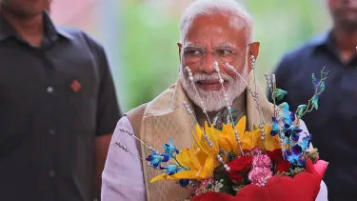





‘Knowledge is power’

Despite Millennia of Oppression, Why Did Not
The Lower Caste And The Untouchables
Revolt Against The Indian Upper Caste?
MIDDLE EAST
World’s
encyclopedic
knowledge
compacted
in
your
hand




Please send your comments directly to the author of the article
Raise the vol to listen to the
lady airing awe @ the SINGLE author encyclopedia
You may also like:
Disturbing stats on black-white inequality
Now girls are a THIRD more likely to go to university than boys
Sound effect: Bhajans (Hindu faith songs) helping Autism
Lessening productivity 50% of Americans have worked with a hangover
Scientists say fist bump is healthier than handshake ?Hug & kiss
Meet Darknet, the hidden underbelly of the searchable Web
This symbolism, however, says more. Since a body is healthy only when all organs
function properly as a team, it denies Varna arrogance as 'My Varna is greater.' It
rather highlights the necessity and therefore importance of all Varnas. Although a
teamwork is seen, and it sounds like a commune working for an ideal, unlike in
communism, dharma dictates here.
It does not stop there; it narrates more rules to bring about, what it calls, an
egalitarian society:
The Rules of The Varna System:
1. At birth all are Sudras.
2. Like doctors, lawyers, etc. these Sudras enter into any one of the educated 3
Varnas (Dvija), through aptitude aided training.
it, there was more acceptance than resentment. Even if they thought of a revolt, they were
few, far in-between, uneducated and unaroused.
Well, with all that, revolution had no chance, and that is why it lasted so long. The rigidity is
such that it is even finding it hard to go
away today. Although things are
changing now, Dalit Christians have
petitioned in the UN against the Pope.
3. Absolute power corrupts absolutely
and brings about the arrogance that can't
be good for a healthy society. Since the
addition of a 2nd Varna brings
additional power, if not incompetence,
the addition of the 2nd Varna power is
frowned upon. A filthy rich Brahmin
usurping two Varna powers, for
example, is frowned upon.
4. Almost reminding the justice of some modern judges, it sees no equality in punishment.
Tracing 'uneasy lies the head that wears the crown' and 'he should know better' a Brahmin
gets harder punishment than a Sudra.
5. It is not purity based and, therefore, has no untouchability.
The Caste System: A Hindu Sin
Although the caste system borrows the names - Brahman, Kshatriya, Vaisya and Sudra of
the Varna system, the borrowing and the similarities with the latter end there.
Arguing unmarried men's needs in the priests abusing
kids, although some accuse Catholicism of enhancing
paedophilia, it is not a Catholic teaching. Similarly, the
caste system is not Hindu ordained. Instead, the
casteism act goes against the Hindu teaching and thus
become a Hindu sin.
But then, most Hindus do practice it. And strangely
enough, even people of other faiths, including
Muslims and Christians in India, practice it. The
Catholic Church has even made it official and
categorised churches for the untouchables.
In any case, the caste system is a social institution that
is based on purity that adds untouchability to the four
suggested above. It, therefore, is spoken of as the high
caste and the low caste. Being birth based, a person is
born into the caste of the father, and that remains
unchanged, throughout life.
But
then, with social corruption being the rule, even
the 5 castes could not remain so. Each caste is divided into sub-castes. There could, for
example, be several classes (sub-castes) of Brahmins. In addition, in the absence of the
restrictions, a Brahmin could easily plough the field and still retain the caste by his birth i.e.
Brahmin - albeit a lesser one. Lower caste marriage or other factors, however, could make
one slide down in the caste ladder.
The rigidity not only made the lower caste people suffer, as suggested below but aptitude
lead desire for a different caste job didn't make even the high caste born enthusiast really
happy.
In addition, while Sudras did not have access to the Vedas - the highest scriptures -the
untouchable were simply not allowed to touch the others. It was not only that the latter's
body was impure to the higher caste people, what he or she touched was impure too. Water,
the most important material, touched by them was a no for the rest. Although they were
needed for menial and other jobs for the upper castes, being untouchable they had to live
separately in a different place and with their own amenities. They and the lower caste people
were poor, and violence against them was not uncommon.
Yes, done mostly by the higher caste people, India did have a political revolution and
showing empathy for the ageless distress, they did make discrimination and untouchability
illegal. They also offered reservation to what Gandhi called, the 'Harijans' (God's children).
But the question, 'Why there was no social revolution against the higher castes' still remains.
And the answer is surprisingly found in the understanding of the concept of middle-class in
the economic class system.
The Middle-class Concept:
The Social five castes system has got nothing to do with the economic middle class, but
surprisingly the middle-class concept of the economic three class system better explains it.
This is because, in the upper, middle and lower class tensions, while the upper class gets the
joy of getting respect from all and seeing its paucity, the lower class gets used to giving
respect to the other two, the middle class is in an odd and uneasy position. It looks like it is
at war with itself. Because it has the means to have a comfortable living, it resents ways and
the means of the upper class. But then, as a balancing act, it feels comfortable by the honour
bestowed by the lower class.


The Untouchables in India
Gandhi Who Coined 'Harijans' |





WOMEN’S POWER: ITS PAST, ITS PRESENT, ITS FUTURE: FEMOCRACY
WEB PAGES
OUR OFFERING
UPLOADED ITEMS
OUR EMAIL
kri200@womenspowerbook.org
QUESTION



















